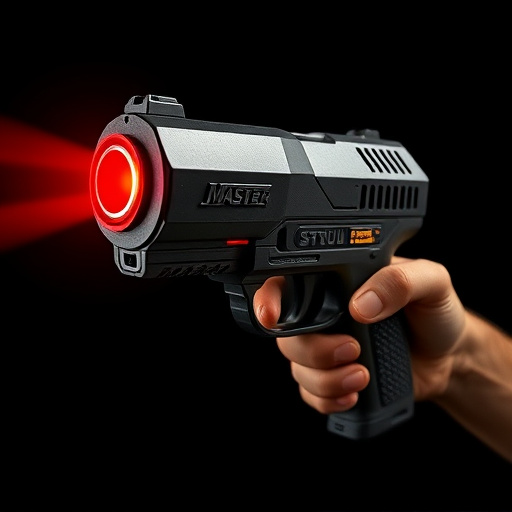The Master Blaster Stun Gun operates by delivering a precisely controlled electric current through its intricate circuitry, causing intense muscle contractions and sensory overload in targets without permanent damage. Its design balances power, safety, and reliability through meticulous engineering of voltage, circuit resistance, electrode placement, and other factors. Safe use requires understanding device limitations, proper training, targeted applications, adherence to local regulations, and responsible storage and maintenance.
In the world of personal safety, Master Blaster stun guns have emerged as powerful tools, delivering intense electric current flows to incapacitate assailants. Understanding the fundamentals of electric current is crucial to appreciating how these devices operate. This article delves into the intricate workings of stun devices, exploring key components, circuitries that convert energy, and the dynamic flow of electricity that leads to their effectiveness. We also examine safety considerations, risks, precautions, and regulations surrounding Master Blaster stun gun usage.
- Understanding Electric Current: The Foundation of Stun Device Operation
- Components and Circuitry: How Master Blaster Stun Guns Convert Energy
- Flow Dynamics: Analyzing the Path and Impact of Electricity in Stun Devices
- Safety Considerations: Risks, Precautions, and Regulations for Stun Gun Users
Understanding Electric Current: The Foundation of Stun Device Operation
Electric current, the flow of charged particles, is the lifeblood of any electronic device, including the master blaster stun gun. Understanding how this current moves and interacts within a stun device is key to comprehending its operation and effectiveness. In simple terms, when you activate a stun gun, an electrical circuit is completed, allowing electrons to rush from the power source (usually a battery) through the device’s internal components and into the target.
This sudden and intense flow of current disrupts the normal functioning of the body’s electrical systems. In the case of a master blaster stun gun, this disruption leads to powerful muscle contractions and sensory overload in the targeted area, temporarily incapacitating the subject. The specific current levels and delivery methods employed by these devices are designed to achieve this effect without causing permanent harm, making them valuable tools for self-defense and law enforcement applications.
Components and Circuitry: How Master Blaster Stun Guns Convert Energy
Master Blaster stun guns, known for their powerful jolts, rely on intricate components and circuitry to convert energy into electrical current flow. These devices typically feature a high-voltage power supply, which can be either battery or recharge-able, serving as the foundation of their operation. The electricity then traverses through a complex circuit, often incorporating capacitors and resistors, designed to amplify the voltage and deliver a sudden, intense burst when activated.
This electric current is channeled through conductive pathways to reach the stun probe or electrodes, which are strategically placed on the device for direct contact with the target. The combination of these components ensures that the Master Blaster stun gun delivers a strong electrical discharge, temporarily disabling the subject without causing permanent harm, making it a popular choice for self-defense and law enforcement applications.
Flow Dynamics: Analyzing the Path and Impact of Electricity in Stun Devices
The flow dynamics of electricity in stun devices, like the Master Blaster stun gun, are a crucial aspect of their design and functionality. When activated, an electric current traverses through the device’s circuit board, coils, and ultimately, the electrodes. This path is meticulously engineered to ensure maximum impact on the target. The current flows rapidly, delivering a powerful shock that disrupts nerve signals, causing muscular paralysis and disorientation.
Understanding this flow is essential for optimizing the stun gun’s effectiveness. Factors like the resistance in the circuit, the shape and placement of electrodes, and the voltage output all contribute to the overall shock intensity and range. Engineers strive to balance these elements to create a reliable, potent, and safe stun device, ensuring users can count on its performance in critical situations.
Safety Considerations: Risks, Precautions, and Regulations for Stun Gun Users
When using a master blaster stun gun, safety should be the top priority for any user. Stun devices deliver an electric shock, which can have serious health implications if not handled correctly. Risks associated with improper use include temporary or permanent muscle paralysis, heart rhythm disturbances, and even respiratory arrest, especially in individuals with pre-existing medical conditions or those taking certain medications. To mitigate these risks, users must understand the device’s functionality and limitations, ensuring they are trained to deploy it safely and effectively.
Precautions should be taken when carrying and using a stun gun, such as avoiding physical altercations whenever possible, targeting specific body zones for optimal effectiveness while minimizing damage, and never aiming or firing at sensitive areas like the eyes or genitals. Staying up-to-date with local regulations is crucial; laws regarding stun guns vary widely, and users must ensure they comply to avoid legal repercussions. Proper storage and maintenance of the device are also essential to prevent accidental activation and prolong its lifespan.
Stun devices, particularly the Master Blaster stun guns, operate on a fundamental principle of electric current flow. By understanding how electricity moves through these devices, we can better appreciate their effectiveness and safety implications. The article has explored key aspects, from the basics of electric current to the intricate circuitry that powers Master Blaster stun guns. We’ve also delved into the dynamics of current flow and highlighted critical safety considerations for users. Armed with this knowledge, folks can make informed decisions when navigating the world of stun devices, ensuring their safety and maximizing the impact of these powerful tools.
